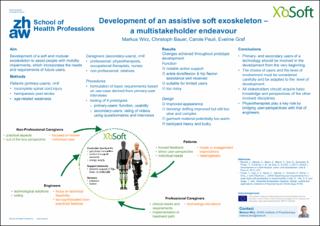Please use this identifier to cite or link to this item:
https://doi.org/10.21256/zhaw-19150| Publication type: | Conference poster |
| Type of review: | Peer review (abstract) |
| Title: | Development of an assistive soft exoskeleton : a multistakeholder endeavour |
| Authors: | Wirz, Markus Bauer, Christoph Pauli, Carole Graf, Eveline |
| et. al: | No |
| DOI: | 10.21256/zhaw-19150 |
| Conference details: | World Confederation of Physical Therapy Congress, Geneva, 10-13 May 2019 |
| Issue Date: | May-2019 |
| Publisher / Ed. Institution: | ZHAW Zürcher Hochschule für Angewandte Wissenschaften |
| Language: | English |
| Subjects: | Exoskeleton; User-centred-design; XoSoft |
| Subject (DDC): | 610: Medicine and health 620: Engineering |
| Abstract: | Background As in other areas, digitalization and new technologies become increasingly relevant for physiotherapy. However, often these developments are driven by technological feasibility rather than by clinical demand. In order to grant maximum acceptability and effective implementation of a technology multiple stakeholders i.e. engineers, patients and therapists need to collaborate throughout the planning and development processes. Here, we describe the design and development of three prototype-generations of a soft and modular exoskeleton. Purpose Development of a soft and modular exoskeleton, which incorporates the needs and requirements of future users. Methods Nine research groups including therapists, designers and engineers from seven European countries were involved in this project. As stakeholders we considered patients with gait limitations due to stroke, incomplete spinal cord injury or age-related weakness (primary end-users, PU), therapists with professional experience in the area of the PU’s conditions and non-professional carers (secondary end-users, SU). The perspectives of PU and SU were incorporated into the technical concepts adopting a user-centered design approach. The initial prototype was designed according to the requirements, which were derived from use-cases representing the target populations. Evaluations of all prototypes were performed using semi-structured interviews with both, PU and SU. Functions of the respective prototypes were evaluated with a predefined testing protocol. The conclusions of the evaluations were fed back to the engineers and informed the development of the consecutive prototypes. All data collection procedures were approved by the local ethics committee and participants provided written informed consent. Results In total eight PU and eight SU were recruited. In general, the prototypes were in an early stage of development and the operation required staff with engineering knowledge and an experimental laboratory. In general, PU and SU rated the technology positively. The individually analyzed data from the interviews and functionality tests revealed heterogeneous results indicating the diversity of the PU’s functional impairments and expectations of PU and SU. Conclusions Based on this project’s experience, we are convinced that future PU and SU of a technology must be involved in the development from the very beginning. However, in order to obtain adequate feedback, the choice of individuals (PU and SU) and the level of involvement must be considered carefully. For example, inadequate expectations may draw the attention to irrelevant issues. In our project, research physiotherapists played a key role by bridging PU and SU with engineers. This information exchange was partially challenging because of different areas of interest, different terminology and geographical distance. Implications A common understanding of the project goals among the project teams and adherence to timelines are essential for successful progress such a large project. The project should assure that all stakeholders can acquire basic knowledge and perspectives of the other involved stakeholders, especially from other disciplines. Specifically for physiotherapists, basic and continuing education should incorporate technological knowledge from engineering disciplines in order to enable physiotherapists to contribute to the development of new devices. This opens the chance to participate in the development of technology for clinical applications. Funding acknowledgements This work has received funding from the European Union’s Horizon 2020 research and innovation programme under grant agreement No. 688175 (XoSoft). |
| URI: | https://www.abstractstosubmit.com/wcpt2019/archive/#/viewer/abstract/2348 https://www.abstractstosubmit.com/wcpt2019/archive/#/viewer/2348 https://digitalcollection.zhaw.ch/handle/11475/19150 |
| Fulltext version: | Published version |
| License (according to publishing contract): | Licence according to publishing contract |
| Departement: | School of Health Sciences |
| Organisational Unit: | Institute of Physiotherapy (IPT) |
| Published as part of the ZHAW project: | XoSoft – soft modular biomimetic exoskeleton to assist people with mobility impairments |
| Appears in collections: | Publikationen Gesundheit |
Files in This Item:
| File | Description | Size | Format | |
|---|---|---|---|---|
| 190507_Poster_WCPT2019_Wirz.pdf | 419.33 kB | Adobe PDF |  View/Open |
Show full item record
Wirz, M., Bauer, C., Pauli, C., & Graf, E. (2019, May). Development of an assistive soft exoskeleton : a multistakeholder endeavour. World Confederation of Physical Therapy Congress, Geneva, 10-13 May 2019. https://doi.org/10.21256/zhaw-19150
Wirz, M. et al. (2019) ‘Development of an assistive soft exoskeleton : a multistakeholder endeavour’, in World Confederation of Physical Therapy Congress, Geneva, 10-13 May 2019. ZHAW Zürcher Hochschule für Angewandte Wissenschaften. Available at: https://doi.org/10.21256/zhaw-19150.
M. Wirz, C. Bauer, C. Pauli, and E. Graf, “Development of an assistive soft exoskeleton : a multistakeholder endeavour,” in World Confederation of Physical Therapy Congress, Geneva, 10-13 May 2019, May 2019. doi: 10.21256/zhaw-19150.
WIRZ, Markus, Christoph BAUER, Carole PAULI und Eveline GRAF, 2019. Development of an assistive soft exoskeleton : a multistakeholder endeavour. In: World Confederation of Physical Therapy Congress, Geneva, 10-13 May 2019 [online]. Conference poster. ZHAW Zürcher Hochschule für Angewandte Wissenschaften. Mai 2019. Verfügbar unter: https://www.abstractstosubmit.com/wcpt2019/archive/#/viewer/abstract/2348
Wirz, Markus, Christoph Bauer, Carole Pauli, and Eveline Graf. 2019. “Development of an Assistive Soft Exoskeleton : A Multistakeholder Endeavour.” Conference poster. In World Confederation of Physical Therapy Congress, Geneva, 10-13 May 2019. ZHAW Zürcher Hochschule für Angewandte Wissenschaften. https://doi.org/10.21256/zhaw-19150.
Wirz, Markus, et al. “Development of an Assistive Soft Exoskeleton : A Multistakeholder Endeavour.” World Confederation of Physical Therapy Congress, Geneva, 10-13 May 2019, ZHAW Zürcher Hochschule für Angewandte Wissenschaften, 2019, https://doi.org/10.21256/zhaw-19150.
Items in DSpace are protected by copyright, with all rights reserved, unless otherwise indicated.